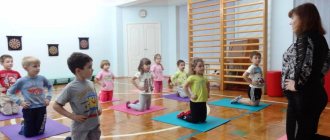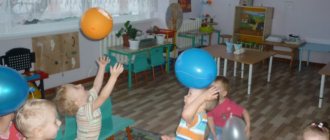Card file on cultural and hygienic skills for children of the first junior group
Marina Makhorina
Card file on cultural and hygienic skills for children of the first junior group
Card file on cultural and hygienic skills,
for children of the 1st junior group .
Card No. 1 “I myself”
.
Goal: to consolidate the ability to eat carefully, take food only with a spoon, improve food culture skills ; teach children to hold a spoon correctly, eat and drink food without spilling, and chew thoroughly. Teach politely to express a request for help; secure, knows how to independently remove shoes and clothes and put them in a closet.
Card No. 2 “Clean nose”
.
Goal: to encourage children to take care of their appearance, use a handkerchief in a timely manner, and cultivate neatness and independence.
Card No. 3 “Scented soap”
.
Goal: to encourage children to independently take soap from a soap dish, rub their palms, rinse off the soap, and know the location of their towel.
Card No. 4 “We love to wash ourselves”
.
Goal: to develop cultural and hygienic skills in children , to promote the correct use of an individual towel, comb, handkerchief, to develop cultural and hygienic skills in children , to consolidate the ability to hang a towel in place, a comb, a handkerchief, and put it away in their locker.
Card No. 5 “Table Behavior”
.
Goal: to develop cultural and hygienic self-service skills in children , to teach them to sit correctly at the table and use cutlery.
Card No. 6 “Dressing and undressing”
.
Goal: to consolidate the ability to unfasten and fasten Velcro fasteners, practice using other types of fasteners, continue to teach them to follow the rules of behavior in the locker room, and ask for help using polite words.
Card No. 7 “We wash our hands correctly”
.
Goal: to develop basic cultural and hygienic skills in children , to teach them to wash their hands correctly, thoroughly dry each finger, and hang a towel in its place.
Card No. 8 “Water, water”
.
Goal: to develop the ability to take soap from a soap dish, lather your hands until white foam, and wash off dirt well; develop independence and the ability to wash hands correctly and thoroughly.
Card No. 9 “We eat”
.
Goal: to develop the ability to eat independently and neatly, sit calmly at the table, maintaining the correct posture, and teach to hold a spoon in the right hand.
Card No. 10 “Where is my towel?”
.
Goal: to encourage children to find their own towel, thoroughly dry their face and hands, and hang it up; develop spatial orientation and attentiveness.
Card No. 11 “Shoes in Places”
.
Goal: to develop self-care skills in children , to teach them to place shoes carefully near the crib, to put on their own shoes after sleep
Card No. 12 “Clean hands”
.
Goal: to strengthen the ability to wash hands correctly and carefully: lather thoroughly, rinse off the soap well; wipe dry with a towel; strengthen children's , teach them to wash their hands correctly, tell them why it is important to wash your hands thoroughly after a walk, using the toilet, and before eating.
Card No. 13 “I’m learning to do everything myself!”
.
Goal: to continue to encourage children to dress and put on their own shoes, to be friendly to each other, and to develop communication skills.
Card No. 14 “Put your pants on, put your feet on!”
.
Goal: to encourage children to dress and put on their own shoes, to be friendly to each other, and to develop communication skills.
Card No. 15 “Put the chair in place”
.
Goal: to teach children to correctly pick up a chair and carefully put it in place; develop spatial orientation and coordination of movements.
Card No. 16 “Shoes”
.
Goal: to teach yourself how to unfasten and fasten Velcro fasteners, and practice using other types of fasteners.
Card No. 17 “I’m already big!”
.
Goal: to consolidate the ability to sit correctly at the table, eat carefully, take food only with a spoon, use a napkin; improve food culture skills .
Card No. 18 “Clean!”
.
Goal: to teach children to take care of their appearance, to play carefully with sand, not to take it with their hands, to put themselves in order in a timely manner, to cultivate neatness and independence.
Card No. 19 “Where is my high chair?”
.
Goal: to teach children to find their chair , to take it correctly and carefully place it near the table, to introduce children to the rules of safe behavior in a group .
Card No. 20 “Things in Places”
.
Goal: to develop in children the ability to take clothes out of the locker and put them back in place after undressing, to fold everything carefully; to teach children to verbally express a request for help, to develop the ability to behave calmly in the dressing room.
Card No. 21 “That’s who we are!”
.
Goal: to teach children to behave correctly at the table, to eat carefully, not to disturb other children, and not to leave the table without the permission of adults.
Card No. 22 “We are big!”
.
Goal: to teach children to put on shorts, put on shoes, and distinguish between the right and left shoe; develop self-care skills
Card No. 23 “We are at the table!”
.
Goal: to train children in the ability to hold a spoon correctly, eat carefully, and not crumble bread on the table; cultivate table manners .
Card file on education of cultural and hygienic skills
Card index for the education of cultural and hygienic skills in the first junior group.
Card No. 1
1. Regime process: Nutrition.
Skill content
: Teach children to hold a spoon in their right hand.
Methodological techniques. Game situation: “How mom taught the bear to eat properly”
.
2. Regime process: Dressing - undressing.
Skill content
: Learn how to get outdoor shoes. Teach verbally, express a request for help, teach how to behave calmly in the locker room.
Methodological techniques. Didactic exercise: “The shoes quarreled and became friends”
.
3. Regime process: Washing.
Skill content
: Learn to take soap from a soap dish and, with the help of adults, soap your hands.
Methodological techniques. Didactic exercise “How we wash our palms and wring out our hands”
.
Card No. 2
1. Regime process: Nutrition.
Skill content
: Learn to take food with your lips.
Methodological techniques. Reading nursery rhyme: “Okay, okay”
.
2. Regime process: Dressing-Undressing.
Skill content
: Encourage to put on socks, a jacket or sweater, a jacket, a hat.
Methodological techniques. Didactic game “Dress the doll for a walk”
. Continue to teach verbally, express a request for help, teach how to behave calmly in the locker room.
3. Regime process: Washing.
Skill content
: Teach children to rub their palms together, put the soap in place.
Methodological techniques. Looking at pictures
:
. ” Conversation on them.
Card No. 3
1. Regime process: Nutrition.
Skill content
: Continue teaching how to hold a spoon in your right hand.
Methodological techniques. Reading nursery rhyme: “Okay, okay”
2. Regime process: “Dressing-Undressing”
.
Skill content
: Teach children to remove tights from the upper body. Continue to teach verbally, express a request for help, teach how to behave calmly in the locker room.
Methodological techniques. Reading nursery rhyme: “Our Masha is little”
.
3. Regime process: Washing
Skill content
: Teach children to wash off soap and know the location of their towel.
Methodological techniques. Looking at pictures
:
“Mom washes her daughter
.
Conversation on them. Reading the nursery rhyme:
. ”
Card No. 4
1. Regime process: Nutrition.
Skill content
: Continue teaching children to take food with their lips and eat with the help of adults.
Methodological techniques. Game situation: “How mom taught the bear to eat properly”
.
2. Regime process: “Dressing-Undressing”
.
Skill content
: Teach verbally, express a request for help, teach how to behave calmly in the locker room. Continue to teach verbally, express a request for help, teach how to behave calmly in the locker room.
Methodological techniques. Didactic exercise “Undress the doll after a walk”
.
Reading the nursery rhyme by Z. Alexandrov “Katya in the manger”
.
3. Regime process: Washing
Skill content
: Teach children, with the help of an adult, to dry their hands.
Methodological techniques. Looking at pictures
: Children wash their hands."
Reading the nursery rhyme: “Water-water...”
.
Card No. 5
1. Regime process: Nutrition.
Skill content
: “To consolidate the ability to hold a spoon in the right hand.
Methodological techniques. Reading a nursery rhyme: “The cat went to market”
2. Regime process: “Dressing-Undressing”
.
Skill content
: Encourage children to take off their dress or shirt, then their shoes, before going to bed. Continue to teach verbally, express a request for help, teach how to behave calmly in the locker room.
Methodological techniques. Reading “My Bear”
, N. Pavlova
“Whose shoes”
3. Regime process: Washing
Skill content
: Continue learning to lather your hands and wash them with straight movements.
Methodological techniques. Looking at the illustration “Children wash their hands”
and a conversation about it.
Card No. 6
1. Regime process: Nutrition.
Skill content
: Strengthen children’s ability to take food with their lips.
Methodological techniques. Reading nursery rhyme: “There comes a horned goat”
.
2. Regime process: “Dressing-Undressing”
.
Skill content
: Teach children how to properly remove tights and hang clothes on a chair. Continue to teach the rules of behavior in the locker room.
Methodological techniques. Reading N. Pavlov “Whose Shoes”
3. Regime process: Washing
Skill content
: Learn to wring out your hands after washing.
Methodological techniques. Didactic exercise “How we wash our palms and wring out our hands”
Card No. 7
1. Regime process: Nutrition.
Skill content
: Teach children to bite food into small pieces.
Methodological techniques. Reading nursery rhymes: “The cat went to market....”
,
“Kitsonka - purr”
2. Regime process: “Dressing-Undressing”
.
Skill content
: Learn to fasten Velcro, practice using other types of fasteners. Continue to teach the rules of behavior in the locker room.
Methodological techniques. Game situation: “How the cockerel woke up the children in the morning”
.
3. Regime process: Washing
Skill content
: Strengthen the ability to soap your hands and wash them with straight movements.
Methodological techniques. Reading a nursery rhyme: “Water, water...”
Card No. 8
1. Regime process: Nutrition.
Skill content
: Strengthen children’s ability to chew with molars, not front teeth.”
Methodological techniques. Reading a nursery rhyme by Z. Alexandrov”, “Delicious porridge”
.
2. Regime process: “Dressing-Undressing”
.
Skill content
: Learn to put on shoes, button a coat with the help of an adult, hang clothes in a closet. Continue to teach the rules of behavior in the locker room.
Methodological techniques. Didactic exercise: “Let’s put the doll to sleep”
3. Regime process: Washing
Skill content
: Reinforce the ability to dry your hands with your towel and hang it up
Methodological techniques. Didactic exercise: “Let’s show the bear how to wipe his hands and face with a towel”
.
Card No. 9
1. Regime process: Nutrition.
Skill content
: Improve the ability to eat independently, finishing everything to the end.
Develop neatness skills
.
Methodological techniques. Didactic exercise: “Let's tell Winnie the Pooh how to behave at the table.
2. Regime process: “Dressing-Undressing”
.
Skill content
: Continue teaching children how to fasten buttons. Learn how to politely express a request for help.
Methodological techniques. Game situation “How we helped the doll get ready to visit the bear. Didactic exercise “Let’s teach little animals how to fasten buttons”
3. Regime process: Washing
Skill content
: Teach children to roll up their sleeves before washing. Strengthen the ability to use a handkerchief.
Methodological techniques. Didactic exercise: “Let’s teach a bear (bunny, doll)
wash yourself properly"
Card No. 10
1. Regime process: Nutrition.
Skill content
: Improve the ability to swallow food without leaving it behind the cheek.
Methodological techniques. Reading a nursery rhyme: “I’ll bake a pie for Tanya...”
2. Regime process: “Dressing-Undressing”
.
Skill content
: Teach children to put on socks, knee socks, starting with the toe. Continue to teach, politely express a request for help.
Methodological techniques. Didactic exercise: “Let’s make an accordion out of a sock”
.
3. Regime process: Washing
Skill content
: Teach children to wash their face without splashing water. Strengthen the ability to use a handkerchief.
Methodological techniques. Reading K. Chukovsky “Moidodyr”
, E. Blaginina
“Alyonushka”
.
Card No. 11
1. Regime process: Nutrition.
Skill content
: Continue the ability to finish eating everything on your own. Learn to use a napkin
Methodological techniques. Didactic exercise “Let’s help the little animals set the table for dinner”
2. Regime process: “Dressing-Undressing”
.
Skill content
: When undressing before going to bed, encourage him to hang his dress or shirt over the back of a chair. Continue to teach, politely express a request for help.
Methodological techniques. Didactic exercise: “Let’s show the bear how to fold his clothes before going to bed”
3. Regime process: Washing
Skill content
: Continue teaching children to roll up their sleeves before washing. Teaches children to comb short hair.
Methodological techniques. Looking at the illustration “Children wash their hands”
and a conversation about it. Reading nursery rhymes.
Card No. 12
1. Regime process: Nutrition.
Skill content
: Continue children's ability to swallow food without leaving it behind the cheek. Continue learning how to use a napkin.
Methodological techniques. Game situation “How the bunny learned to eat”
Reading the nursery rhyme by E. Blaginina
“Alyonushka”
.
2. Regime process: “Dressing-Undressing”
.
Skill content
: When undressing, encourage children to put tights and shorts on the seat. Continue to teach, politely express a request for help.
Methodological techniques. Didactic exercise: “Let’s show the bear how to fold his clothes before going to bed”
3. Regime process: Washing
Skill content
: Teach children not to wet their clothes while washing. Strengthen the ability to use a handkerchief.
Methodological techniques. Looking at the illustration “Children wash their hands”
and a conversation about it. Reading Nursery Rhymes.
Card No. 13
1. Regime process: Nutrition.
Skill content
: Teach children to hold a spoon correctly with three fingers.
Methodological techniques. Didactic exercise: “Let’s tell Khryusha how to eat properly”
2. Regime process: “Dressing-Undressing”
.
Skill content
: Strengthen the ability to dress and undress correctly with a little help from adults.
Methodological techniques. Didactic exercise: “Let’s show the bear how to fold his clothes before going to bed.
3. Regime process: Washing
Skill content
: Strengthen children’s ability to wring out their hands after washing.
Methodological techniques. Didactic exercise “How we wash our palms and wring out our hands”
Card No. 14
1. Regime process: Nutrition.
Skill content
: Teach children to eat the broth
of the first
course along with dressing, the main dish and a side dish.
Continue to develop neatness skills
.
Methodological techniques. Reading by S. Kaputikyan “Who is most likely to finish drinking, “Masha is having lunch”
.
2. Regime process: “Dressing-Undressing”
.
Skill content
: Strengthen children’s ability to place their things in the closet, fold and hang clothes on a chair before bed.
Methodological techniques. Didactic exercise: “Let’s teach the bear to put things in the locker”
3. Regime process: Washing
Skill content
: Ensure that children do not get their clothes wet while washing.
Methodological techniques. Looking at pictures
:
“Greasy girl”
,
“Neat girl”
.
Card No. 15
1. Regime process: Nutrition.
Skill content
: Teach children to hold a spoon correctly with three fingers. Continue learning how to use a napkin.
Methodological techniques. Game situation “The bear invited a bunny and a hedgehog to visit”
2. Regime process: “Dressing-Undressing”
.
Skill content
: Continue teaching children how to use different types of fasteners.
Methodological techniques. Reading: And Ant “I myself”
.
Didactic exercise: “Let’s teach the little animals how to fasten buttons”
3. Regime process: Washing
Skill content
: Reinforce
hand washing and washing skills
Methodological techniques. Looking at pictures
:
“Mom washes her daughter”
Card No. 16
1. Regime process: Nutrition.
Skill content
: consolidate the ability to eat carefully, improve
food culture skills
.
Methodological techniques. Reading: S Kaputikyan “Who will finish drinking sooner”
,
“Masha is having lunch”
2. Regime process: “Dressing-Undressing”
.
Skill content
: Continue to strengthen the ability to dress and undress correctly.
Methodological techniques. Reading I. Muraveyk “I myself”
, N. Pavlova
“Whose shoes”
3. Regime process: Washing
Skill content
: Continue to reinforce
skills
. Continue combing your short hair.
Methodological techniques. Reading familiar nursery rhymes ( “Water-water...”
etc.)




